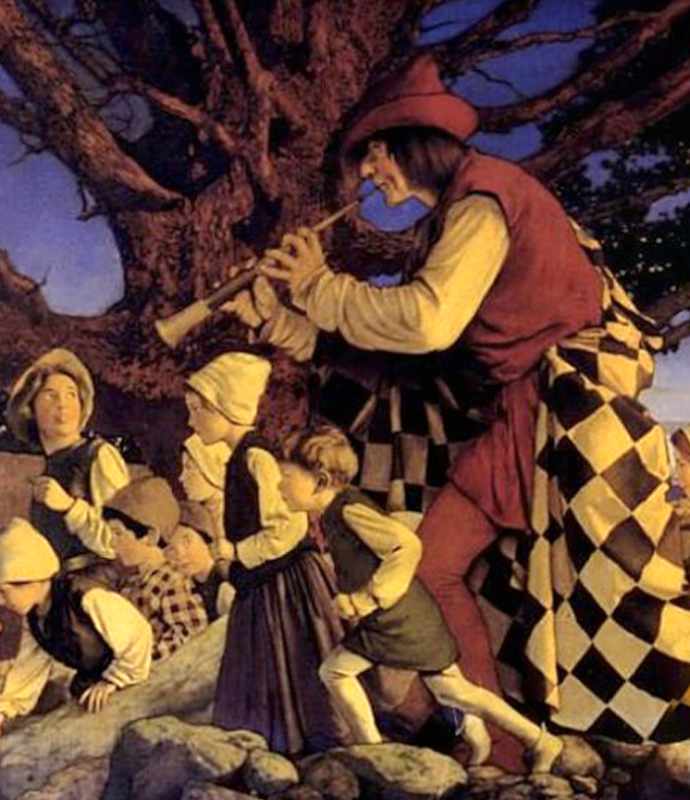The Pied Piper of Hamelin (also known as the Pan Piper or the Rat-Catcher of Hamelin) is the title character of a legend from the town of Hamelin (Hameln), Lower Saxony, Germany. The legend dates back to the Middle Ages, the earliest references describing a piper, dressed in multicolored (“pied”) clothing, who was a rat catcher hired by the town to lure rats away with his magic pipe. When the citizens refuse to pay for this service as promised, he retaliates by using his instrument’s magical power on their children, leading them away as he had the rats. This version of the story spread as folklore and has appeared in the writings of Johann Wolfgang von Goethe, the Brothers Grimm, and Robert Browning, among others. The phrase “pied piper” has become a metaphor for a person who attracts a following through charisma or false promises. There are many contradictory theories about the Pied Piper. Some suggest he was a symbol of hope to the people of Hamelin, which had been attacked by plague; he drove the rats from Hamelin, saving the people from the epidemic. The earliest known record of the story originates from the town of Hamelin itself, depicted in a stained glass window created for the church of Hamelin, which dates to around 1300. Although the church was destroyed in 1660, several written accounts of the tale have survived.
| Alias Pied Piper |
| Real Names/Alt Names Unknown |
| Characteristics Villain, Musician, Trickster, Myths & Legends, Medieval Age, German |
| Creators/Key Contributors Unknown |
| First Appearance German folklore |
| First Publisher ○ |
| Appearance List Literature: “Pied Piper of Hamelin” by Johann Wolfgang von Goethe (Poem, 1803), Deutsche Sagen by the Brothers Grimm (1816), “Pied Piper of Hamelin” in Dramatic Lyrics by Robert Browning (1842), The Pied Piper of Hamelin by Robert Browning (1888), Krysař by Viktor Dyk (The Rat-Catcher, 1915), The Rat-Catcher by Marina Tsvetaeva (serialized in the émigré journal Volia Rossii in 1925–1926), et. al. Film: “The Pied Piper” in Silly Symphonies series (Disney, 1933), et. al. Comics: “The Town on the Edge of the End” in Pogo Stepmother Goose by Walt Kelly (1954). Television: The Pied Piper of Hamelin (1957). Podcast: Astonishing Legends: Episode 168-169 The Pied Piper of Hamelin. |
| Sample Read Astonishing Legends: Episode 168 The Pied Piper of Hamelin [YT] |
| Description The Pied Piper of Hamelin (also known as the Pan Piper or the Rat-Catcher of Hamelin) is the title character of a legend from the town of Hamelin (Hameln), Lower Saxony, Germany. The legend dates back to the Middle Ages, the earliest references describing a piper, dressed in multicolored (“pied”) clothing, who was a rat catcher hired by the town to lure rats away with his magic pipe. When the citizens refuse to pay for this service as promised, he retaliates by using his instrument’s magical power on their children, leading them away as he had the rats. This version of the story spread as folklore and has appeared in the writings of Johann Wolfgang von Goethe, the Brothers Grimm, and Robert Browning, among others. The phrase “pied piper” has become a metaphor for a person who attracts a following through charisma or false promises. There are many contradictory theories about the Pied Piper. Some suggest he was a symbol of hope to the people of Hamelin, which had been attacked by plague; he drove the rats from Hamelin, saving the people from the epidemic. The earliest known record of the story originates from the town of Hamelin itself, depicted in a stained glass window created for the church of Hamelin, which dates to around 1300. Although the church was destroyed in 1660, several written accounts of the tale have survived. |
| Source Pied Piper of Hamelin – Wikipedia |

